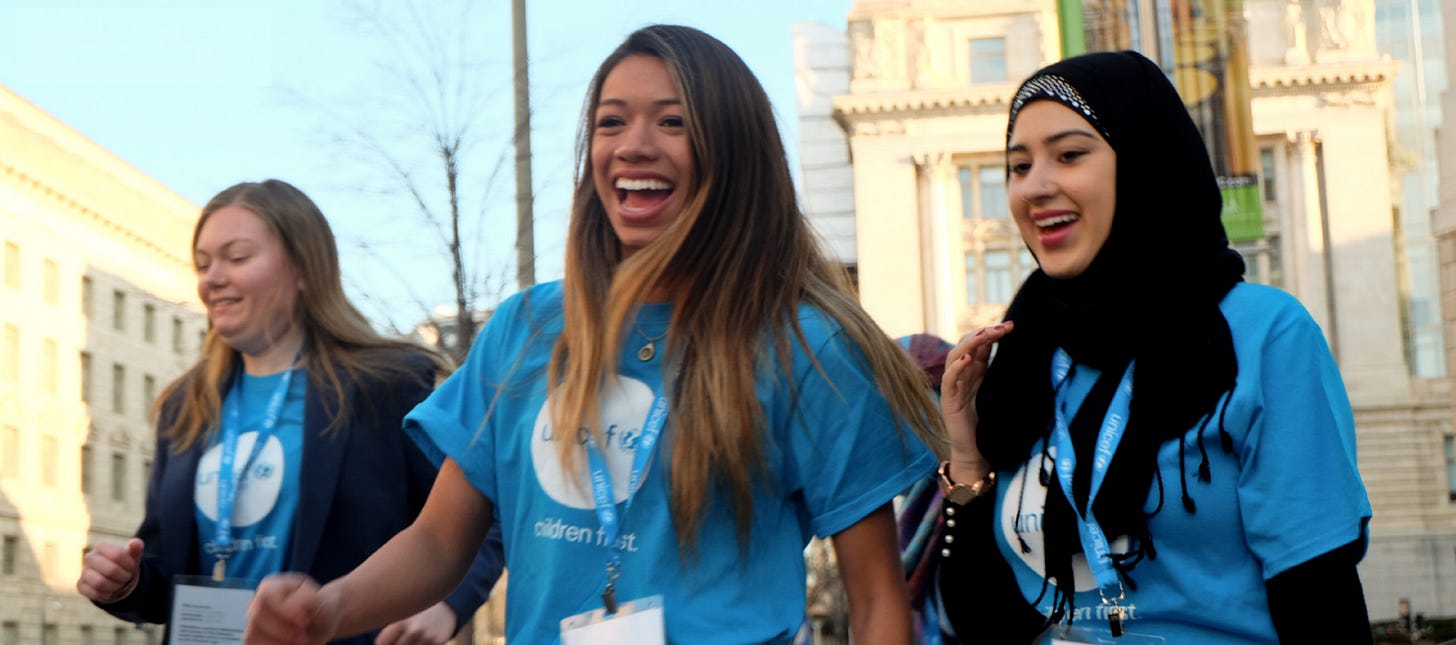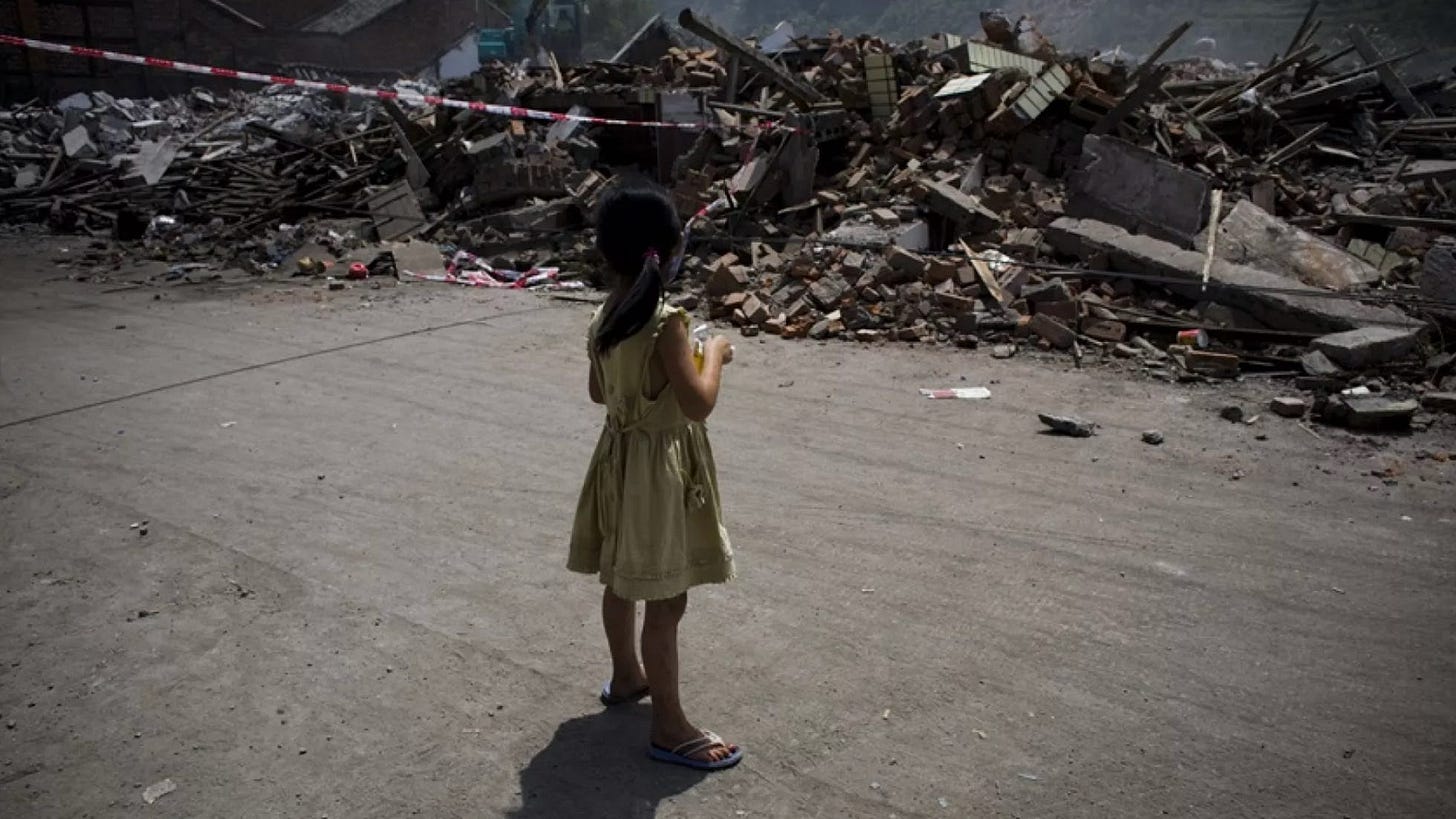In May of 2008, a devastating earthquake hit my home province of Sichuan. More than 7,000 classrooms collapsed and 20,000 students were killed or injured. Backpacks, schoolbooks, tiny shoes were unearthed from the rubble. Entire classrooms buried. Within hours, government, medical, and military assistance descended upon the region. They were joined by international aid from the Red Cross, Mercy Corps, Habitat for Humanity, Oxfam, World Vision, UNICEF, and countless others. In the months that followed, they united to rescue, relocate, and rebuild.
That summer, as the world’s attention shifted northeast to the Beijing Olympics, I returned to a nearby vicinity where my extended family lived. As my uncle’s van inched closer to the heart of rescue and relief activity in Wenchuan County, the weight of human suffering far eclipsed the crushing August heat.
Relatives had warned me over phone, but nothing prepared me for this.
Through the dusty van window, remains of collapsed buildings stood like crooked teeth planted along the smog-gray skyline, scenes of anonymous suffering. But if I allowed myself to zoom in and truly examine the scene, each piece of debris was someone’s kitchen tile, someone’s shoe, someone’s story cut unjustly short.
When the car came to a stop, I was too scared to step out.
Each piece of debris was someone’s kitchen tile, someone’s shoe, someone’s story cut short.
It wasn’t until a girl my age, who recognized my uncle’s van, ran to greet us that I finally got out of the car. Her name was Tiantian, a diminutive for 天, meaning “sky” or “heaven”. Some days I can still hear Tian’s laugh, the one she had when she first saw me: a soft city-dweller in impractically white clothing crying inside her uncle’s van. It took one and half sobs to realize she was laughing (two more to get angry), but by then she had offered to help me out. I made a new friend.
Like mine, Tian’s family was lucky: they hadn’t lived or worked near the worst shocks. Others weren’t. I later met kids who lost parents, relatives, neighbors, limbs.
On the ground in Sichuan that summer, the air was thick with dust and grief. I watched as crew hauled rubble and families pieced together fragments of lives that would never feel whole again. The smell of collapsed buildings lingered, mingling with desperate cries of families who continued the search for missing relatives in disbelief. The weight of loss blanketed everyone, everywhere.
One evening on a shared TV, we caught snippets of the Beijing Opening Ceremony.
There, just 1,500 kilometers away, the world watched China unfurl itself in a show of grandeur. The Bird’s Nest stadium glowed under fireworks that lit up the capital’s night sky, while athletes marched and commentators marveled at the country’s rise. It choreographed 2,008 drummers in perfect unison.
Here was a nation that was polished, powerful, ascendant.
On screen, China sparkled with possibility. Around me, I saw a more nuanced view: a government that had done as much as it could, with the help of international aid and NGOs. And yet, grieving parents held onto their kid’s backpacks in disbelief, waiting for answers that never came. Moreover, because of the one-child policy, each loss meant not only the death of a child, but the erasure of an entire family’s future.
The weight of these parallel truths—two things can be true at once—stayed with me long after that summer. In the 16 years since then, I’ve gotten to see UNICEF’s lifesaving work around the world. What I learned along the journey:
Pull back the curtain. While spectators marveled at the Olympics in Beijing, I witnessed a different kind of power in Sichuan: the courage to keep giving when earth itself has betrayed you. Real stories live in the space between tragedy and hope—in Tian’s laughter that enlivened the village, in parents who lost their own children but still helped neighbors search through the rubble. Real stories dig past the spectacle to find the beating heart beneath.
Find poetry in unexpected places. Not in grand gestures or polished broadcasts when we know 2 billion people are watching, but in quiet acts of grace. On my last day in Sichuan, I found a red jade charm had been braided onto my purse after I’d forgotten it overnight on a public work bench. In a place where families were still sifting through rubble for photos of their children, where every salvaged possession was precious, someone had chosen not to take, but to give.
Choose the stories worthy of being told. We are all storytellers, advocates, civic participants, and stewards of information. With every click, like, subscribe, and comment on social media, we vote for the stories to amplify. If we can bridge the gap between spectacle and suffering, if we can illuminate the dignity in disaster, we might build a more compassionate response to human suffering. We pick which stories get told and which stories get buried.
In crisis, we are stripped to our essence.
In crisis, we don't merely survive: we find ways to preserve our dignity, culture, and capacity for joy. From 7-year-old Varvara in Ukraine, who insists on doing her homework by flashlight to prepare for a future she refuses to stop believing in, to Tian’s gesture of friendship from the summer of 2008, each act of defiance is an act of creation, of human resilience in the face of crisis.
UNICEF’s commitment for every child has taught me that humanitarian work isn’t merely about rebuilding from loss or recovering from disaster, but about safeguarding the spectrum of human experience: grief and gratitude, trauma and triumph.
Crisis reveals not only what we’ve lost, but what we refuse to let go: our capacity for kindness, our hunger for stories, our quest for hope.
As 2024 draws to a close and we reflect on the legacy we wish to give to the world, I still feel the weight of the red jade charm in my palm. Even in our darkest moments, we can still weave hope into a stranger's story. Every water pump installed, every classroom rebuilt, every child vaccinated is an act of faith in tomorrow. Every donation, every volunteer hour, every shared story adds another stitch to the global tapestry of support. In doing so, we deliver not just aid, but dignity; not just supplies, but hope to the world's most vulnerable children.
Together, we can make something beautiful.




